Progranulin gene delivery reduces plaque burden and synaptic atrophy in a mouse model of Alzheimer's disease
- PMID: 28837568
- PMCID: PMC5570501
- DOI: 10.1371/journal.pone.0182896
Progranulin gene delivery reduces plaque burden and synaptic atrophy in a mouse model of Alzheimer's disease
Abstract
Progranulin (PGRN) is a multifunctional protein that is widely expressed throughout the brain, where it has been shown to act as a critical regulator of CNS inflammation and also functions as an autocrine neuronal growth factor, important for long-term neuronal survival. PGRN has been shown to activate cell signaling pathways regulating excitoxicity, oxidative stress, and synaptogenesis, as well as amyloidogenesis. Together, these critical roles in the CNS suggest that PGRN has the potential to be an important therapeutic target for the treatment of various neurodegenerative disorders, particularly Alzheimer's disease (AD). AD is the leading cause of dementia and is marked by the appearance of extracellular plaques consisting of aggregates of amyloid-β (Aβ), as well as neuroinflammation, oxidative stress, neuronal loss and synaptic atrophy. The ability of PGRN to target multiple key features of AD pathophysiology suggests that enhancing its expression may benefit this disease. Here, we describe the application of PGRN gene transfer using in vivo delivery of lentiviral expression vectors in a transgenic mouse model of AD. Viral vector delivery of the PGRN gene effectively enhanced PGRN expression in the hippocampus of Tg2576 mice. This elevated PGRN expression significantly reduced amyloid plaque burden in these mice, accompanied by reductions in markers of inflammation and synaptic atrophy. The overexpression of PGRN was also found to increase activity of neprilysin, a key amyloid beta degrading enzyme. PGRN regulation of neprilysin activity could play a major role in the observed alterations in plaque burden. Thus, PGRN may be an effective therapeutic target for the treatment of AD.
Conflict of interest statement
Figures

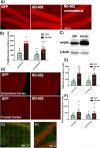
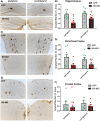
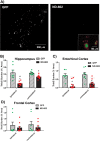
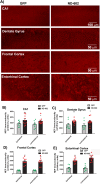

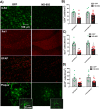

Similar articles
-
Progranulin protects against amyloid β deposition and toxicity in Alzheimer's disease mouse models.Nat Med. 2014 Oct;20(10):1157-64. doi: 10.1038/nm.3672. Epub 2014 Sep 28. Nat Med. 2014. PMID: 25261995 Free PMC article.
-
The Role of PGRN in Alzheimer's Disease.Mol Neurobiol. 2016 Aug;53(6):4189-4196. doi: 10.1007/s12035-015-9358-0. Epub 2015 Jul 28. Mol Neurobiol. 2016. PMID: 26215834 Review.
-
Opposing effects of progranulin deficiency on amyloid and tau pathologies via microglial TYROBP network.Acta Neuropathol. 2017 May;133(5):785-807. doi: 10.1007/s00401-017-1668-z. Epub 2017 Jan 9. Acta Neuropathol. 2017. PMID: 28070672 Free PMC article.
-
Reducing amyloid plaque burden via ex vivo gene delivery of an Abeta-degrading protease: a novel therapeutic approach to Alzheimer disease.PLoS Med. 2007 Aug;4(8):e262. doi: 10.1371/journal.pmed.0040262. PLoS Med. 2007. PMID: 17760499 Free PMC article.
-
Microglial Progranulin: Involvement in Alzheimer's Disease and Neurodegenerative Diseases.Cells. 2019 Mar 11;8(3):230. doi: 10.3390/cells8030230. Cells. 2019. PMID: 30862089 Free PMC article. Review.
Cited by
-
Innate Immune Response to Viral Vectors in Gene Therapy.Viruses. 2023 Aug 24;15(9):1801. doi: 10.3390/v15091801. Viruses. 2023. PMID: 37766208 Free PMC article. Review.
-
Progranulin and neuropathological features of Alzheimer's disease: longitudinal study.Aging Clin Exp Res. 2024 Mar 5;36(1):55. doi: 10.1007/s40520-024-02715-9. Aging Clin Exp Res. 2024. PMID: 38441695 Free PMC article.
-
Regulatory Mechanisms and Therapeutic Implications of Lysosomal Dysfunction in Alzheimer's Disease.Int J Biol Sci. 2025 Jan 13;21(3):1014-1031. doi: 10.7150/ijbs.103028. eCollection 2025. Int J Biol Sci. 2025. PMID: 39897039 Free PMC article. Review.
-
Development of AL101 (GSK4527226), a progranulin-elevating monoclonal antibody, as a potential treatment for Alzheimer's disease.Alzheimers Res Ther. 2025 Jul 25;17(1):174. doi: 10.1186/s13195-025-01817-4. Alzheimers Res Ther. 2025. PMID: 40713730 Free PMC article. Clinical Trial.
-
AAV-Mediated Progranulin Delivery to a Mouse Model of Progranulin Deficiency Causes T Cell-Mediated Toxicity.Mol Ther. 2019 Feb 6;27(2):465-478. doi: 10.1016/j.ymthe.2018.11.013. Epub 2018 Nov 17. Mol Ther. 2019. PMID: 30559071 Free PMC article.
References
-
- Baker M, MacKenzie IR, Pickering-Brown SM, J. G, Rademakers R, Lindholm C, et al. Mutations in progranulin cause tau-negative frontotemporal dementia linked to chromosome 17. Nature. 2006;442:916–9. doi: 10.1038/nature05016 - DOI - PubMed
-
- Ahmed Z, MacKenzie IR, Hutton M, Dickson D. Progranulin in frontotemporal lobar degeneration and neuroinflammation. J Neuroinflammation. 2007;4:7 doi: 10.1186/1742-2094-4-7 - DOI - PMC - PubMed
-
- Ohmi K, Greenberg DS, Rajavel KS, Ryazantsev S, Li HH, Neufeld EF. Activated microglia in cortex of mouse models of mucopolysaccharidoses I and IIIB. Proc Natl Acad Sci U S A. 2003;100(4):1902–7. doi: 10.1073/pnas.252784899 - DOI - PMC - PubMed
-
- Irwin D, Lippa CF, Rosso A. Progranulin (PGRN) expression in ALS: an immunohistochemical study. Journal of Neurological Science. 2009;276(1–2):9–13. - PubMed
-
- Ahmed Z, Sheng H, Xu Y, Lin WL, Innes AE, Gass J, et al. Accelerated lipofuscinosis and ubiquitination in granulin knockout mice suggest a role for progranulin in successful aging. Am J Pathol. 2010;177(1):311–24. doi: 10.2353/ajpath.2010.090915 - DOI - PMC - PubMed
MeSH terms
Substances
LinkOut - more resources
Full Text Sources
Other Literature Sources
Medical
Molecular Biology Databases

